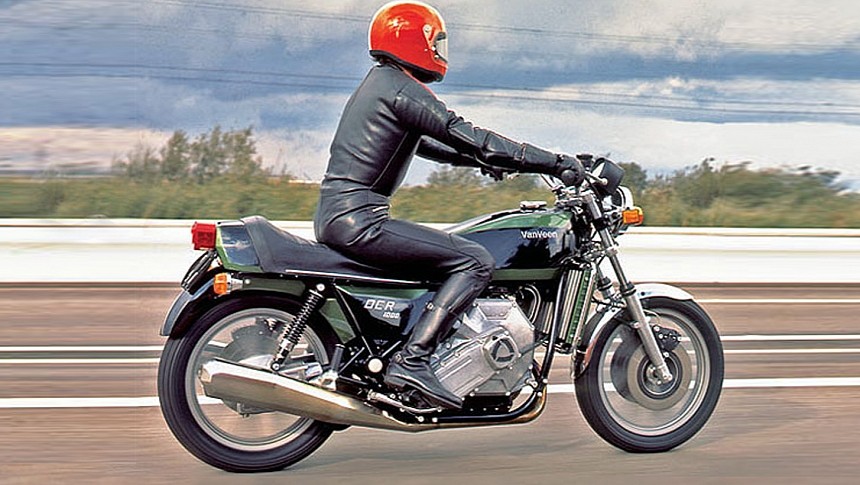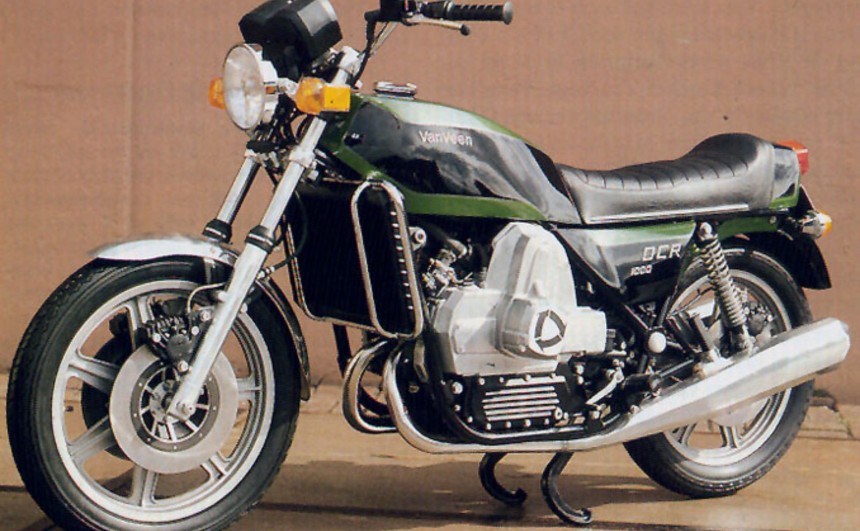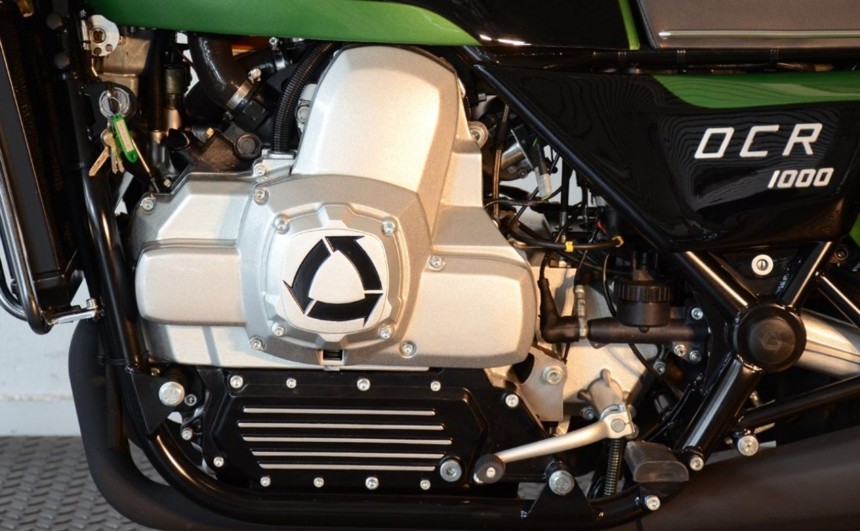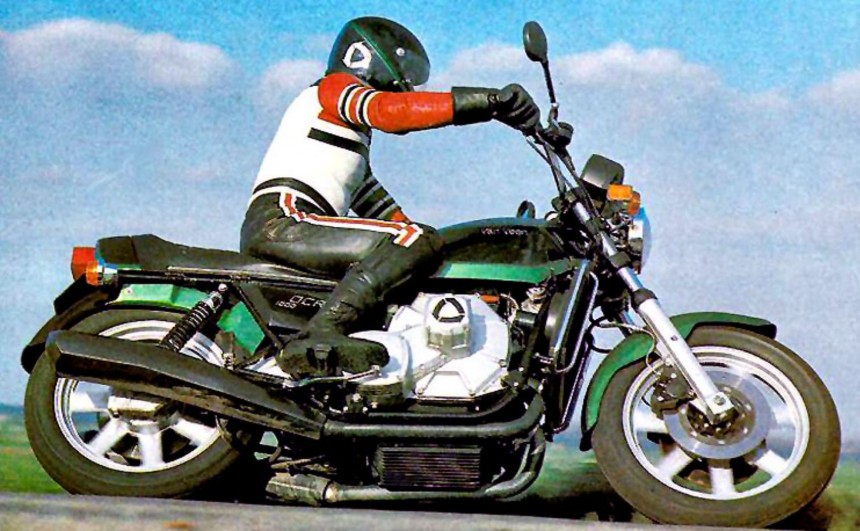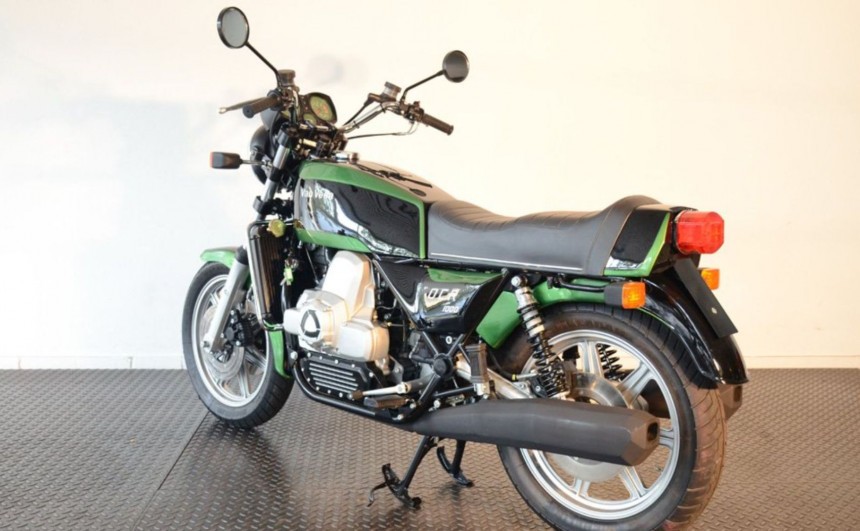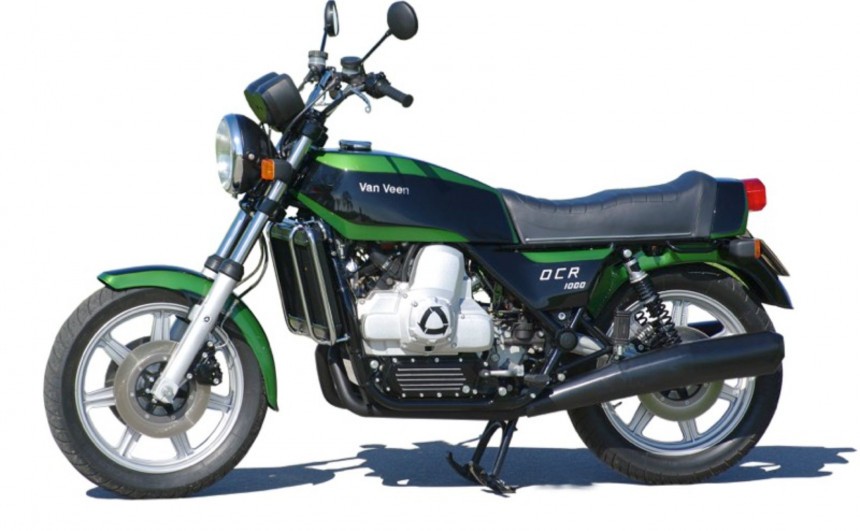Unveiled in 1973, the OCR 1000 was the world's first production motorcycle to feature an automotive-derived, twin-rotor engine, and its creators dubbed it the finest, most technologically advanced superbike that money could buy.
After Felix Wankel presented his innovative motor in January 1960, many engineers around the globe were convinced that the faith of the traditional piston engine was sealed.
Lighter, more compact, and featuring fewer moving parts than standard reciprocating piston units, the rotary engine had the potential to revolutionize the industry and reder the good ol' piston engine obsolete.
But, like all things that sound too good to be true, Wenkel's rotary design had many drawbacks.
While unquestionably more efficient than a traditional engine of similar size in terms of power potential, the rotary gobbled up more gas and oil than a much larger piston motor.
Then, there was the questionable long-term reliability. Though it had far fewer moving parts, they were subjected to intense wear and tear. The main problem that Wankel and many others struggled with was the rapid degeneration of the apex (rotor tip) seals, which caused combustion gas leaks.
Nevertheless, that didn't discourage manufacturers from paying the fee required to license the design and attempt to solve its inherent issues.
During the 1960s and 1970s, most companies who bet on the Wankel were part of the automotive industry, but a few decided to experiment with the revolutionary engine on motorcycles.
That early period's first two-wheeled example that made it into production was Suzuki's RE5, a single-rotor bike styled by none other than the famous Giorgetto Giugiaro.
But, the same year the RE5 went into production, a Dutch company called Van Veen unveiled the twin-rotary-powered OCR 1000, which aimed to be the finest, most technologically advanced production superbike the world had ever seen.
Its story starts with Henk van Veen, a man who made a living by importing German-built 50cc Kreidler motorcycles.
A huge fan of racing anything with two wheels, he established Van Veen Racing, which helped boost the notoriety of the bikes he imported by winning numerous 50cc trophies.
But while extremely proud of his team's achievements, van Veen had a far more ambitious plan brewing in his head: building a Wankel-powered superbike.
With the determination, financial means, and the right crew to turn his ambition into reality, van Veen soon had a functional prototype.
Designed by former Grand Prix racer Jos Schurgers, the prototype was constructed around a modified Moto Guzzi frame.
To test the feasibility of the Wankel, a twin-rotor borrowed from a Mazda was fitted onto the frame.
The entire test mule reportedly looked awful, but after a lengthy development phase, the resulting OCR 1000 was a stunning bike that still look good half a century later.
Though opting for a Mazda engine for the production version would've been a wiser choice, Van Veen eventually struck a deal with Luxemburg-based Comotor, a joint venture between NSU and Citroen that manufactured a Wankel for the latter carmaker.
Even if it was developed by a new company with no prior experience building a production superbike, the innovative OCR 1000 looked impressive.
It was built around a bespoke frame equipped with a 42-mm telescopic fork, adjustable twin rear shocks, hydraulic Brembo brakes, and all the premium hardware a rider could hope for.
While the gorgeous, premium appearance was enough to draw those in attendance at the 1974 Cologne Motorcycle Exhibition to the Van Veen booth, the feature that blew people's minds was its rotary engine.
Neatly nestled into the frame and adorned with brushed aluminum cases, the 996 cc two-rotor promised to deliver 100 unprecedently smooth horses through a Porsche-designed gearbox and a drive shaft.
The public was in awe, and the OCR 1000 managed to eclipse the all-new Honda Gold Wing, a future legend of the touring segment.
The specialty press also wrote generally positive articles about the model, praising its built quality, surprisingly good handling for its massive 700-pound (317 kg) weight, and, of course, its audacious automotive-derived engine.
There was one thing nobody liked about the OCR 1000: its price. The equivalent of roughly $15,000 (or $104,751 in 2023 money), it made the innovative Van Veen one of the most expensive production motorcycles in the world.
Nevertheless, wealthy riders who wanted what promised to be one of the greatest superbikes on the market were lining up to order one.
But then, things went downhill.
Despite showing a lot of promise, the Comotor rotary was plagued by a host of reliability issues that postponed the start of production for no less than four years.
To make matters worse, Citroen started making headlines by attempting to buy back and scrap the GS Birotor examples it had sold since the engine, shared with the OCR 1000, proved disastrously unreliable.
Van Veen finally started production of their innovative bike in 1978, promising engine revisions that would increase long-term reliability.
But by then, Comotor was preparing to close its gates, and negative press around the engine drove away many potential customers.
In the end, the Dutch company only managed to build 38 units between 1979 and 1981, when production ceased.
In less than a decade, the OCR 1000 went from a two-wheel superstar to a footnote on the back pages of motoring history books.
Years after production ended, Dutch Wankel specialist Ger van Rootselaar purchased the tooling, drawings, molds, and remaining components, aiming to revive the model.
Unfortunately, van Rootselaar never managed to secure enough funds, but the bike was briefly revived in 2010, thanks to Dirk Knip and Andries Wielinga.
The duo purchased everything OCR 1000-elated from van Rootselaar and built ten improved units. Though more reliable than the original, the revival was just as expensive, selling for $115,000.
As for the initial 38 units, most of them have survived and reside in Europe. They are currently some of the most sought-after classic motorcycles on the Old Continent, with the value for a well-kept example exceeding the $100,000 mark.
While some may dismiss it as an obscenely expensive failure, the innovative Van Veen OCR 1000 was a few bad decisions away from reaching legendary status.
Price and engine reliability issues aside, it was a remarkably well-built motorcycle devised by a company that compensated for the apparent lack of experience with dedication and boldness.
If you want to take a virtual tour of this fascinating superbike, we recommend watching the YouTube video below by Bullpen Cycles.
Lighter, more compact, and featuring fewer moving parts than standard reciprocating piston units, the rotary engine had the potential to revolutionize the industry and reder the good ol' piston engine obsolete.
But, like all things that sound too good to be true, Wenkel's rotary design had many drawbacks.
While unquestionably more efficient than a traditional engine of similar size in terms of power potential, the rotary gobbled up more gas and oil than a much larger piston motor.
Then, there was the questionable long-term reliability. Though it had far fewer moving parts, they were subjected to intense wear and tear. The main problem that Wankel and many others struggled with was the rapid degeneration of the apex (rotor tip) seals, which caused combustion gas leaks.
Nevertheless, that didn't discourage manufacturers from paying the fee required to license the design and attempt to solve its inherent issues.
During the 1960s and 1970s, most companies who bet on the Wankel were part of the automotive industry, but a few decided to experiment with the revolutionary engine on motorcycles.
An ambitious plan
But, the same year the RE5 went into production, a Dutch company called Van Veen unveiled the twin-rotary-powered OCR 1000, which aimed to be the finest, most technologically advanced production superbike the world had ever seen.
Its story starts with Henk van Veen, a man who made a living by importing German-built 50cc Kreidler motorcycles.
A huge fan of racing anything with two wheels, he established Van Veen Racing, which helped boost the notoriety of the bikes he imported by winning numerous 50cc trophies.
But while extremely proud of his team's achievements, van Veen had a far more ambitious plan brewing in his head: building a Wankel-powered superbike.
Starting with a Mazda unit but ending up with a Comotor
Designed by former Grand Prix racer Jos Schurgers, the prototype was constructed around a modified Moto Guzzi frame.
To test the feasibility of the Wankel, a twin-rotor borrowed from a Mazda was fitted onto the frame.
The entire test mule reportedly looked awful, but after a lengthy development phase, the resulting OCR 1000 was a stunning bike that still look good half a century later.
Though opting for a Mazda engine for the production version would've been a wiser choice, Van Veen eventually struck a deal with Luxemburg-based Comotor, a joint venture between NSU and Citroen that manufactured a Wankel for the latter carmaker.
The star of the 1974 Cologne Motorcycle Exhibition
It was built around a bespoke frame equipped with a 42-mm telescopic fork, adjustable twin rear shocks, hydraulic Brembo brakes, and all the premium hardware a rider could hope for.
While the gorgeous, premium appearance was enough to draw those in attendance at the 1974 Cologne Motorcycle Exhibition to the Van Veen booth, the feature that blew people's minds was its rotary engine.
Neatly nestled into the frame and adorned with brushed aluminum cases, the 996 cc two-rotor promised to deliver 100 unprecedently smooth horses through a Porsche-designed gearbox and a drive shaft.
The public was in awe, and the OCR 1000 managed to eclipse the all-new Honda Gold Wing, a future legend of the touring segment.
The specialty press also wrote generally positive articles about the model, praising its built quality, surprisingly good handling for its massive 700-pound (317 kg) weight, and, of course, its audacious automotive-derived engine.
An untimely demise
Nevertheless, wealthy riders who wanted what promised to be one of the greatest superbikes on the market were lining up to order one.
But then, things went downhill.
Despite showing a lot of promise, the Comotor rotary was plagued by a host of reliability issues that postponed the start of production for no less than four years.
To make matters worse, Citroen started making headlines by attempting to buy back and scrap the GS Birotor examples it had sold since the engine, shared with the OCR 1000, proved disastrously unreliable.
Van Veen finally started production of their innovative bike in 1978, promising engine revisions that would increase long-term reliability.
But by then, Comotor was preparing to close its gates, and negative press around the engine drove away many potential customers.
In the end, the Dutch company only managed to build 38 units between 1979 and 1981, when production ceased.
The Van Veen OCR 1000 today
Years after production ended, Dutch Wankel specialist Ger van Rootselaar purchased the tooling, drawings, molds, and remaining components, aiming to revive the model.
Unfortunately, van Rootselaar never managed to secure enough funds, but the bike was briefly revived in 2010, thanks to Dirk Knip and Andries Wielinga.
The duo purchased everything OCR 1000-elated from van Rootselaar and built ten improved units. Though more reliable than the original, the revival was just as expensive, selling for $115,000.
As for the initial 38 units, most of them have survived and reside in Europe. They are currently some of the most sought-after classic motorcycles on the Old Continent, with the value for a well-kept example exceeding the $100,000 mark.
While some may dismiss it as an obscenely expensive failure, the innovative Van Veen OCR 1000 was a few bad decisions away from reaching legendary status.
Price and engine reliability issues aside, it was a remarkably well-built motorcycle devised by a company that compensated for the apparent lack of experience with dedication and boldness.
If you want to take a virtual tour of this fascinating superbike, we recommend watching the YouTube video below by Bullpen Cycles.
